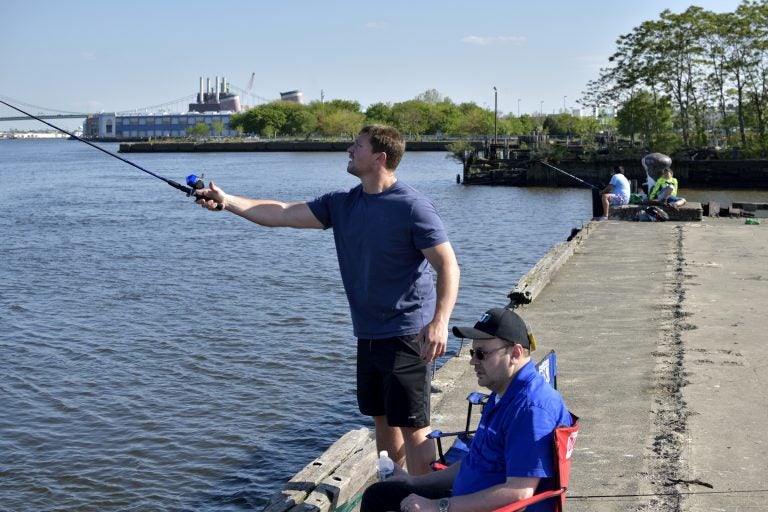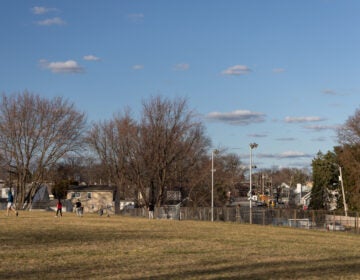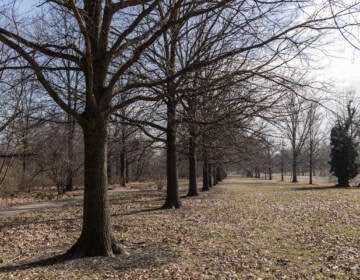At waterfront development site, a popular DIY rec space hangs in the balance
Not exactly hidden, although not exactly in plain sight, the undeveloped oblong pier is a recreational asset for many South Philadelphians.

Fishermen Dustin and John at Pier 60 on the Delaware waterfront, near Tasker Street, in South Philadelphia, PA, on May 12, 2018. (Bastiaan Slabbers/for WHYY)
As rush-hour traffic grinds to a halt along Columbus Boulevard one afternoon in May, a slow flow of bicycles moves in a perpendicular direction, intermittently cutting across the road toward the AAA building at the intersection with Tasker Street. The bicyclists proceed down a beat-up street that trails past a Walmart, dumpsters, and a few shelters for stray cats before eventually opening up to a row of trees through which is revealed an unmarked pier jutting out into the Delaware River.
There’s already a crowd at Pier 60. Teenage boys are skating on rusted marine equipment. Teenage girls dangle their legs over the edge. But most of the people present are waiting for tugs on their fishing poles. The catfish they catch are thrown back into the water, mostly.
Amid Columbus Boulevard’s shopping strips, Pier 60 has long been an eclectic destination. Not exactly hidden, although not exactly in plain sight, the undeveloped oblong pier is a recreational asset for many South Philadelphians that has stood the test of time. It’s a space frequented by immigrants from Laos and Cambodia, contractors of all colors, and kids enjoying the outdoors after school lets out.
Over the years, several plans to develop the pier have not been realized. Meanwhile, other piers have been spruced up. Just a few blocks to the south lies Pier 68, once a DIY fishing space of its own and now a gleaming waterfront park with salvaged-granite benches and solar light poles. All of which makes Pier 60 special, broken glass, graffiti and all.
“In communities where there’s such scarcity of green space, we rely on spaces like [this pier]. Somewhere for people, when they have the time, to go sit under a tree with their families, fish, or contemplate,” said Thoai Nguyen, CEO of SEAMAAC, the Southeast Asian Mutual Assistance Associations Coalition. “The impact of mindless types of activities is actually really helpful to your mental and behavioral health.”
The open space is unlikely to last much longer. A development team spearheaded by local real estate magnate Bart Blatstein seeks to build a series of commercial properties (including a Lidl supermarket) and townhouses there. (Blatstein sold half the land to US Construction, the real estate company overseeing the residential development.) Of the 214 townhouses planned, 45 will extend out onto Pier 60. Those will be single-family homes looking out over the river. The proposed residential community is being called Waterfront Boulevard, named for what would be a brand new street laid down between the homes and the water.
The other 169 townhouses will be set back 50 feet from the water, according to designs submitted to the city’s Civic Design Review Board. The plans — created by the Atrium Design Group, of Old City — call for at least some preservation of public access to the area around Pier 60, albeit access that is not conducive to fishing off the pier. Developers seek to build a “Waterfront Plaza,” with a cafe and rain gardens, that will link up with a six-mile waterfront trail in progress by the Delaware River Waterfront Corporation, the nonprofit behind Pier 68’s renovations. A representative of DRWC confirmed that it is seeking to purchase an easement from the developers to ensure that the potential bike trail is not developed.
In contrast with the commercial portion of the project, the residential portion, by and large, has drawn praise. For the most part, the plans coincide with the values of the 2013 Central Delaware master plan and zoning overlay passed by City Council, which set guidelines for future development along Philadelphia’s eastern river. The master plan was overseen by DRWC. Among the plan’s six key principles is one stating the need to “create a pedestrian-friendly and balanced transportation plan that supports the walkability of the waterfront and its strong connection to the city and the region.”
What has enraged neighbors is a “super” Wawa proposed for the site, or rather, a piece of it: 16 gas pumps that will be put in near the new townhouses. It would be the first gas station on the east side of Columbus Boulevard south of Washington Avenue, and is perceived by many residents to be in conflict with the master plan. “A lot of neighbors see the overlay as a vision that we collectively agreed to pursue,” said Patrick Fitzmaurice, president of the Pennsport Civic Association. “I think the residential portion is in the spirit of the overlay and the master plan. I don’t think the commercial portions reflect that spirit.” (PCA is a member of the Central Delaware Advisory Group, a nonprofit coalition of neighborhood groups that played a key role in the formation and advocacy of the master plan.)
At a March meeting of the civic association, a team representing the developers, including Blatstein, argued with Pennsport residents about the validity of the gas station. But the potential loss of Pier 60 as a recreational hub was never raised. The conversation around development has been happening unbeknownst to most of the pier’s regulars. “I don’t want to jump the gun and say this development is going to be a terrible thing for the community, but SEAMAAC has not heard a peep about this project, and if SEAMAAC doesn’t know about it, then I’m positive that the community [using Pier 60] also doesn’t know about it,” Nguyen said.
Blatstein originally acquired the parcel that includes Pier 60 — 1401-99 Columbus Blvd. — in 1993, only to sell it to a casino operator. Since reacquiring the deed in 2014, he has met neighborhood resistance over his ideas for developing it. If the civic association doesn’t endorse the latest plan, Blatstein could not bring the gas pumps to Pennsport without a zoning variance granted by the city. Arguments for and against the gas pumps are scheduled for a June 19 hearing in front of the Zoning Board of Adjustment. Blatstein has vowed to build the project with or without the gas pumps, although he argues that the site will lose economic viability without them.
Hanging in the balance will be Pier 60. If the zoning board does not grant the variance, access to the space will live another day, and if it does, the loss will be felt by many more people than just advocates of walkability.
“I love any development that is going to bring jobs to the neighborhood and beautify an area that is neglected,” Nguyen said. “But why can’t we carve out a space along the pier that remains public? I’m not really against gentrification. What I’m against is the displacement of working-class people by gentrification. This is certainly not one instance where they’re thinking broadly about community.”
WHYY is your source for fact-based, in-depth journalism and information. As a nonprofit organization, we rely on financial support from readers like you. Please give today.







